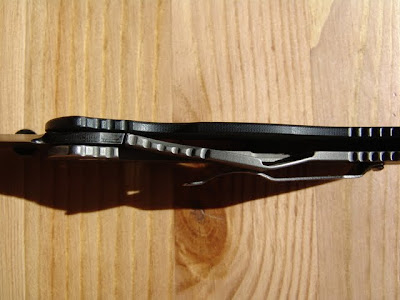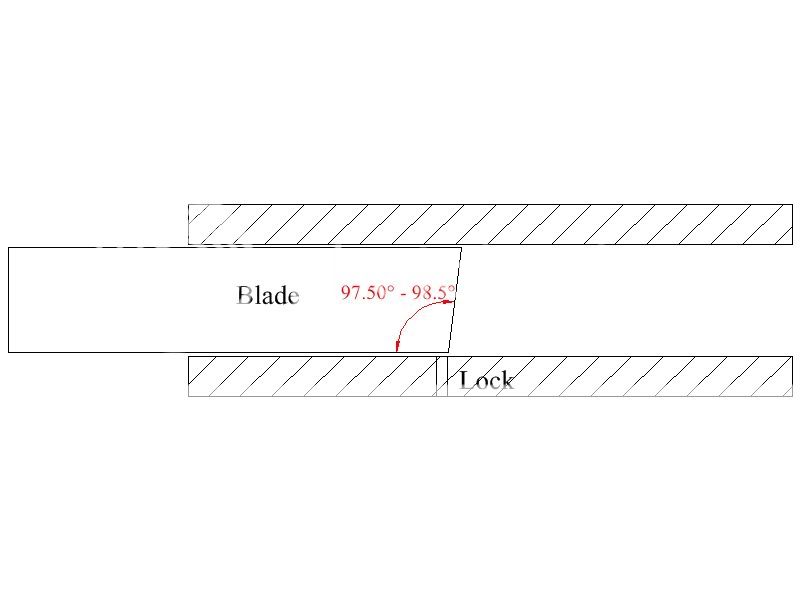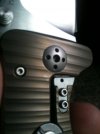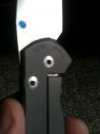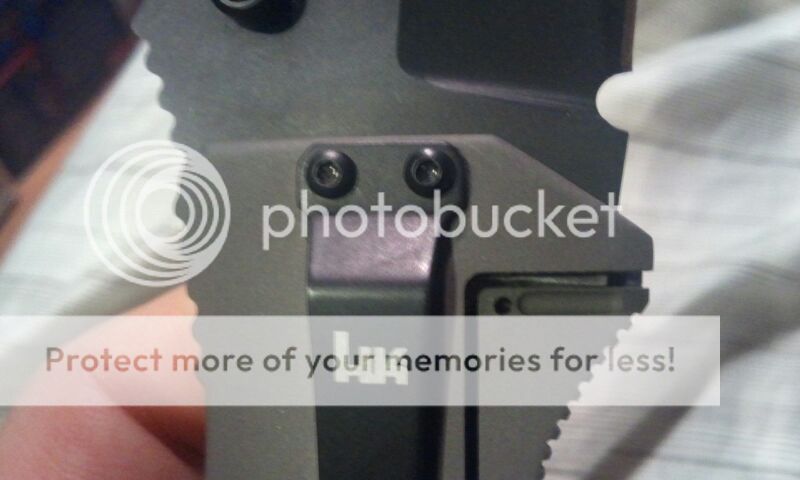Here are some comments from a very well and respected maker on the forums that has tested numerous locks. I will not post his name as this was a private conversation and lets keep it that way.
"I've done some steel inserts in mine. The wear rates are not far off from titanium to steel. Both wear very well. Heat anodizing helps to form a deeper near ceramic hardness on the titanium since heating it by a torch anodizes the ti from the inside out as opposed to using a DC current which is from the outside in or the outside layer only. That ceramic hard oxide layer wears pretty well against even the hardest blades. If it didn't people would have stopped using ti a long time ago.
The real factor as I see it is impact strength not wear resistance. In my own testings for Kershaw and other companies that sent me product to beat the snot out of on their behalf I found that the steel frame knives held up better to sudden shock impacts like spine and overstrike whacking as opposed to the softer ti which could indent easier and deeper scarring the surfaces more. So to me this is the key factor behind it but there is a draw back since steel is less forgiving than titanium. Ti tends to gall or stick to itself and dissimilar metals and this sticking effect has been seen forever by makers as a real benefit.
Not to sound bad but you can be off some on contact angle and get by with it by using ti since it can make up for your shortfallings here whereas steel would just slide right off the contact. Steel will demand the contacts be spot on and if they are not well, you'll see locks sliding off the contact toward release easier than ti when the contact angle is not right.
I've used inserts of steel in a couple folders I did a while back. To me having to do them the way I did they were more trouble than they were worth. Most of my folders give me very little trouble as it is. However, I am low key and not selling what is being marketed as a 'hard use' knife either. We'll see how long this lasts but it could be the beginnings of a trend in the hard use category if people start testing them and find they hold up better. It will depend on the steel used. I really fail to see much benefit if the steel they are using is just 410 stainless at 45 Rockwell. Ti is 39 Rockwell or so and although softer by quite a bit technically it wears at such a slow rate that in normal use most folks are not going to notice any diff or benefit to this insert at all. Its just the guys beating on them that will pick up on it probably.
Now that goes to another issue. What happens when the insert dislodges or falls out? The screws will have to be very secure for some of these guys beating on them and if they think the knife is supposed to take it they will do that. Again time will tell. My thoughts are that overall there are some benefits from the stand point of repairs.
Its much easier to replace an insert to refresh a lock that has worked its way all the way across the contact. This beats the hell out of making a whole new lock or peening the contact like Emerson, Kershaw and many other companies do to repair theirs. Don't get me wrong thats an old cutler trick as old as the liner lock itself and it works. Heck many makers do it as a part of the process along with heat treating because they believe peening compresses the molecules making it denser so it wears better.
The point is that is not as precise as people like to be whereas a new insert would be, well, new and just like it was before theoretically. It may even be something the user can do themselves in the field or at home. We'll just have to see how this develops. "

eening the contact is a technique used by cutlers to 'refresh' the actual physical contact area on the lock where it connects to and wears against the blade in use. Sine the lock is technically supposed to connect and support the blade at the bottom of the lock at the point far enough away from the mid line of the pivot barrel or pin to prevent 'blade roll', (bottom being the area many refer to as the top since its up by the thumb grooves where one depresses the lock to release and free up the blade to close it. Think bottom of the blade when opened and that is technically the bottom of the knife and the where the edge runs with the spine of the blade when opened being at the bottom running along the full length of the folder)
So again since the lock connects at the bottom you have a triad or three points to support the blade when opened. The stop, the pivot in the middle and the lock. If the blade connected to the lock more in the middle or at the top of the lock down where the detent is on most then you would experience blade roll. This is when you have vertical type play but what happens is the blade actually rolls on the lock because the lock connects in the wrong place.
The lock should also be flat not angled at a pitch like the contact is on the blade. Some makers make them and the blade is not quite right so they adjust the lock to fit the blade instead of the blade to fit the lock. This is incorrect and it can cause a 'stepped' or angled pitch to be formed on the lock and that in conjunction with a pitch on the blade is a sure fire way to lead to lock defeats.
When a lock wears and works its way across the tang to the opposite side liner or when it develops blade play many times the maker or the manufacturer will correct this not by bumping up the size of the stop pin but by peening the contact area. This again if you picture it is the area showing signs of wear marks on the lock itself and it should be somewhere on the bottom third of the lock far enough from the mid line of the pivot to make a rock solid contact for no play in the blade. Peening means a ball peen hammer and a 3/32 flat end punch placed precisely at a the area just to the left of the contact on a right handed knife. You swing the hammer hitting the punch so it physically 'squishes' out the contact more toward the blade. When done this creates a little 'bubble' sticking out just a few thousandths of an inch and it refreshes the contact as well as compresses the material. This can be done on steel, ti or brass locks and requires different touches or pressures to do it right. Its been done on compression locks and lock backs also to peen the usually softer area of the rocker arm just a micron or two to adjust the lock for fit before they ship it out the door.
Anodized ti is usually surface only. Heating with a torch usually brings the ti lock contact up to a straw color or at the least a cherry red orange color. Letting it cool on its own and repeating this three times builds up quite a bit of anodizing that at times can be resistant to even bead blasting it off and it can harden the metal to the point that it is much more wear resistant in that spot that was heated. Most are done and then blasted afterwards cleaning off the surface that is seen. Others simply don't treat it knowing that titanium is technically a 'self healing' metal that creates an oxide layer on its own as soon as fresh ti is exposed to oxygen. This is true by the way and why ti is resistant to all kinds of corrosion. Its that oxide layer that forms a barrier between the ti and the atmosphere sealing it off that makes it so resistant to it. Heat and electric current simply stack on layers of this seal and the light refracting off those multi layers is why we see colors. You actually would have to read some of the tech manuals on that to get the full jist. I'll stick with a nut shell description.
Correction. Steel would probably have been dinged also just not as bad and this depends as you said earlier on type of steel, how hard it was set at and so on. Steel as I said requires that things be just so. I repair a lot of knives and most are liner type locks of the thinner type. These wear and indent and even in steel. They also of steel tend to be easier to find fault in contact angles. For example you see a few knives with steep pitch angle contacts 12 degrees or more and to try this with steel will surely cause the locks to defeat with a sharp tap to the spine. Most steel locks need a pitch of 7 to 8 degrees max to work. 10 or above is really pushing it and even Spyderco walks that fine line at times as I see plenty of Military folders with locks that slide toward release back to the flatter area on the blade contact. This with simple spine pressure from my hands so there is no telling how that would go for the user if it was a sharp blow to the spine. "
"Correction:
Peening the contact is a technique used by cutlers to 'refresh' the actual physical contact area on the lock where it connects to and wears against the blade in use. Sine the lock is technically supposed to connect and support the blade at the bottom of the lock at the point far enough away from the mid line of the pivot barrel or pin to prevent 'blade roll', (bottom being the area many refer to as the top since its up by the thumb grooves where one depresses the lock to release and free up the blade to close it. Think bottom of the blade when opened and that is technically the bottom of the knife and the where the edge runs with the spine of the blade when opened being at the (insert TOP not bottom as I said) running along the full length of the folder) Even I get confused. Lay people often mean top when they mean bottom and bottom when they mean top because these two points are confused.
The point is the lock should connect at the bottom third of the lock and no where near the pivot mid line or top. "
And here are some other comments from me and my opinion.
For those like me that like the theory
A recent few posts I did regarding frame locks, but many of the same principles apply to liner locks geometry.
"There are a few things I want to cover, based on my talking with custom makers and reading Bob Terzuola's book: The Tactical Folding Knife (hereafter BT), where he explains in detail the aspects of a good liner lock and the same principles are applied to framelocks.
Three points of contact:
1. Stop pin
2. Pivot pin
3. Interface between blade and spring (ie, lockface/lock engagement area hereafter referred to LF) Spring is also the liner lock, framelock.
This forms a triangle.
Now, the LF is the area lets focus on first.
BT. refers to the angle of the lock face to be between 7.5 and 8.5 degrees. Les then 5 degrees and the spring will jam. More then 10 degrees and the spring will start slipping off the LF.
Now the start of a radius lock face, the maximum therefore cannot exceed 10 degrees or else the lock will start slipping when the lock wears to that point. As mentioned as lock roll in the video when referring to the Strider.
Now.
Do not thing the angle plays the only role in the lock slipping. The finished LF can have a rough spot, not be polished enough, the spring's interface between the LF can also play a role.
Let us examine this from the Emerson website.
http://www.emersonknives.com/ekKnifeAnatomy.php
If the LF connected to the spring more in the middle or at the top of the spring where the detent is on most (point nr 3 closer to the pivot pin nr 2) then you would experience blade roll. This is when you have vertical type play but what happens is the blade actually rolls on the spring because the spring connects in the wrong place with the LF.
The picture shows the extremes of the different designs, you can have a lock that engages more then the bottom 0.90-.125" of the spring. Chris Reeve has proven this, but, you can also have a knife that engages only on that bottom 0.90" (point of contact in the picture)
Not every lock is the same. The basic ingredients are the same, but the final application is what the maker chooses. This can be seen even with Spyderco difference between the Military and the Gayle Bradly.
Now that is just the geometry of the lock.



